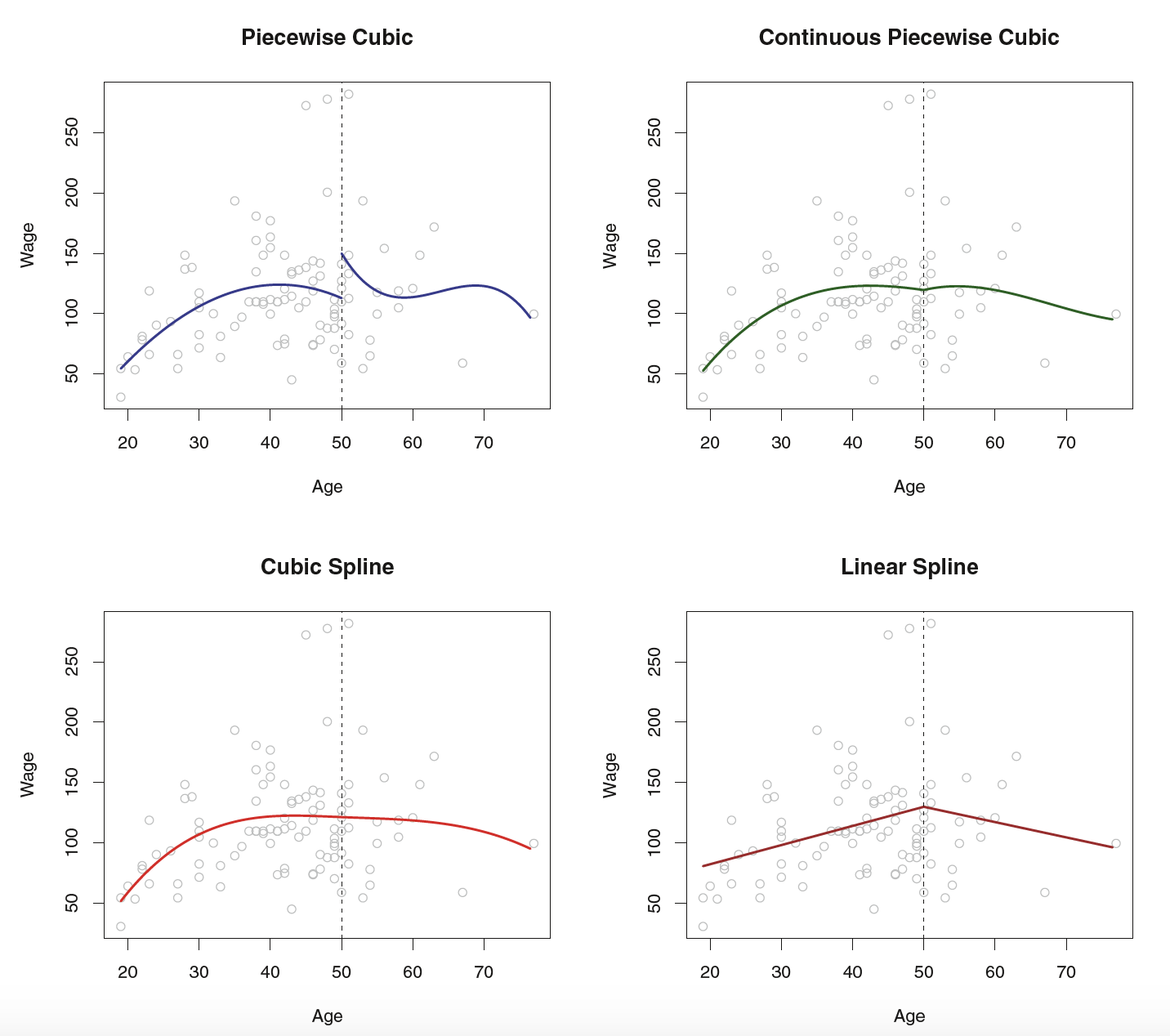Non-linearity in R
Dr. D’Agostino McGowan
1 / 6
Dr. Lucy D'Agostino McGowan
Recall
- Polynomials
2 / 6
Dr. Lucy D'Agostino McGowan
Recall
- Polynomials
- Step functions
2 / 6
Dr. Lucy D'Agostino McGowan
Recall
- Polynomials
- Step functions
- Linear splines
2 / 6
Dr. Lucy D'Agostino McGowan
Recall
- Polynomials
- Step functions
- Linear splines
- Cubic Splines
2 / 6
Dr. Lucy D'Agostino McGowan
Recall
- Polynomials
- Step functions
- Linear splines
- Cubic Splines
- Natural Splines
2 / 6
Dr. Lucy D'Agostino McGowan

3 / 6
Dr. Lucy D'Agostino McGowan
Natural cubic splines
A natural cubic spline extrapolates linearly beyond the boundary knots
4 / 6
Dr. Lucy D'Agostino McGowan
Natural cubic splines
A natural cubic spline extrapolates linearly beyond the boundary knots
- This adds 4 extra constraints and allows us to put more internal knots for the same degrees of freedom as a regular cubic spline

4 / 6
Dr. Lucy D'Agostino McGowan
It's really easy to do this in R!
5 / 6
Dr. Lucy D'Agostino McGowan
It's really easy to do this in R!
- You can transform any continuous (numeric) variable into a natural spline by using the
step_ns()function in arecipe.
5 / 6
Dr. Lucy D'Agostino McGowan
It's really easy to do this in R!
- You can transform any continuous (numeric) variable into a natural spline by using the
step_ns()function in arecipe. - You specify the degrees of freedom that you would like to use for that variable using the
deg_freeparameter
5 / 6
Dr. Lucy D'Agostino McGowan
It's really easy to do this in R!
- You can transform any continuous (numeric) variable into a natural spline by using the
step_ns()function in arecipe. - You specify the degrees of freedom that you would like to use for that variable using the
deg_freeparameter
library(ISLR)auto_rec <- Auto %>% recipe(mpg ~ horsepower) %>% step_ns(horsepower, deg_free = 2)5 / 6
Dr. Lucy D'Agostino McGowan
It's really easy to do this in R!
- You can transform any continuous (numeric) variable into a natural spline by using the
step_ns()function in arecipe. - You specify the degrees of freedom that you would like to use for that variable using the
deg_freeparameter
library(ISLR)auto_rec <- Auto %>% recipe(mpg ~ horsepower) %>% step_ns(horsepower, deg_free = 2)How many degrees of freedom did I allocate to the horsepower variable?
5 / 6
Dr. Lucy D'Agostino McGowan
It's really easy to do this in R!
- You can transform any continuous (numeric) variable into a natural spline by using the
step_ns()function in arecipe. - You specify the degrees of freedom that you would like to use for that variable using the
deg_freeparameter - Instead of specifying
deg_freeyou could usetune()to tune this.
6 / 6
Dr. Lucy D'Agostino McGowan
It's really easy to do this in R!
- You can transform any continuous (numeric) variable into a natural spline by using the
step_ns()function in arecipe. - You specify the degrees of freedom that you would like to use for that variable using the
deg_freeparameter - Instead of specifying
deg_freeyou could usetune()to tune this.
auto_rec <- Auto %>% recipe(mpg ~ horsepower) %>% step_ns(horsepower, deg_free = tune())6 / 6